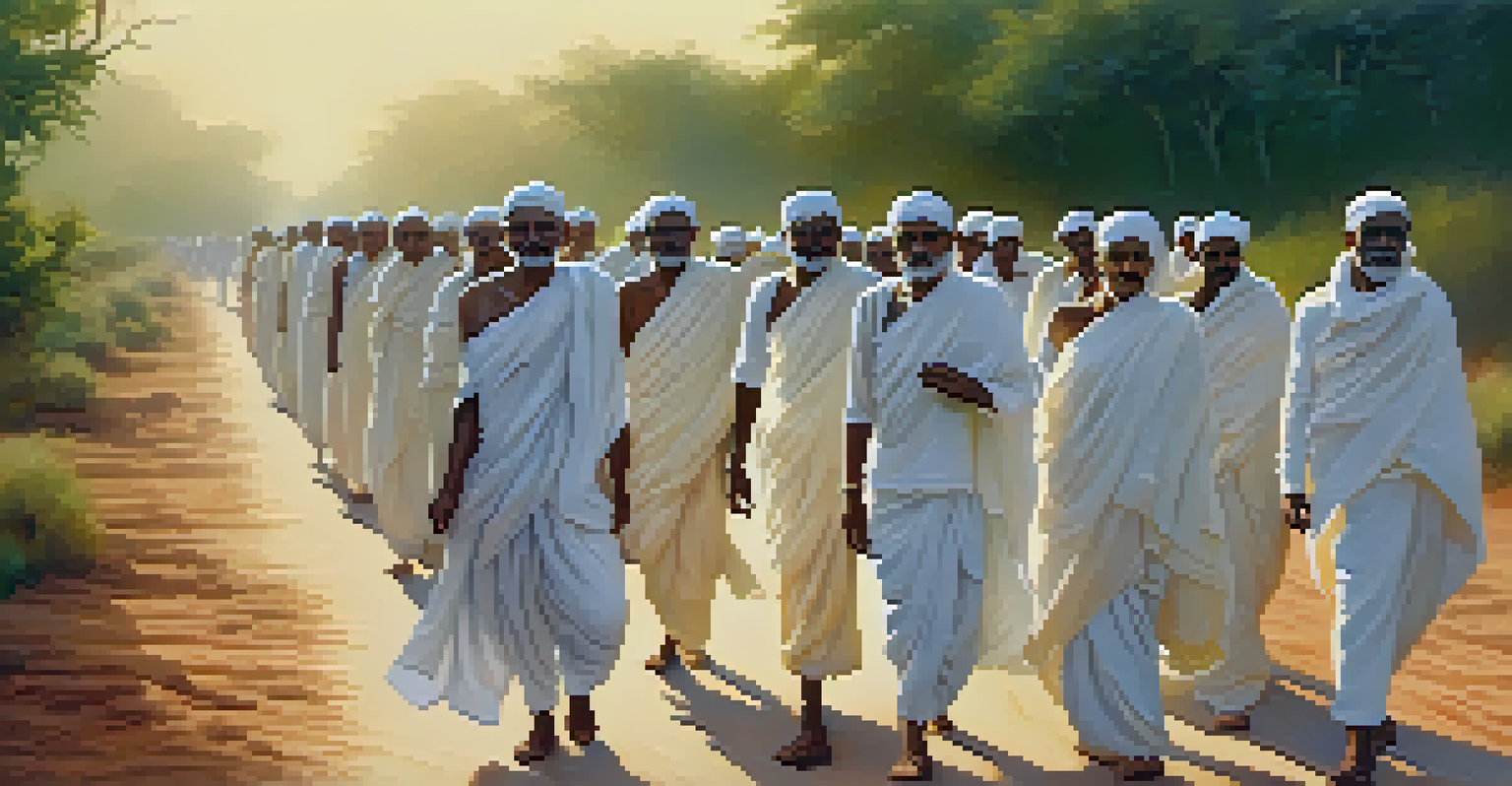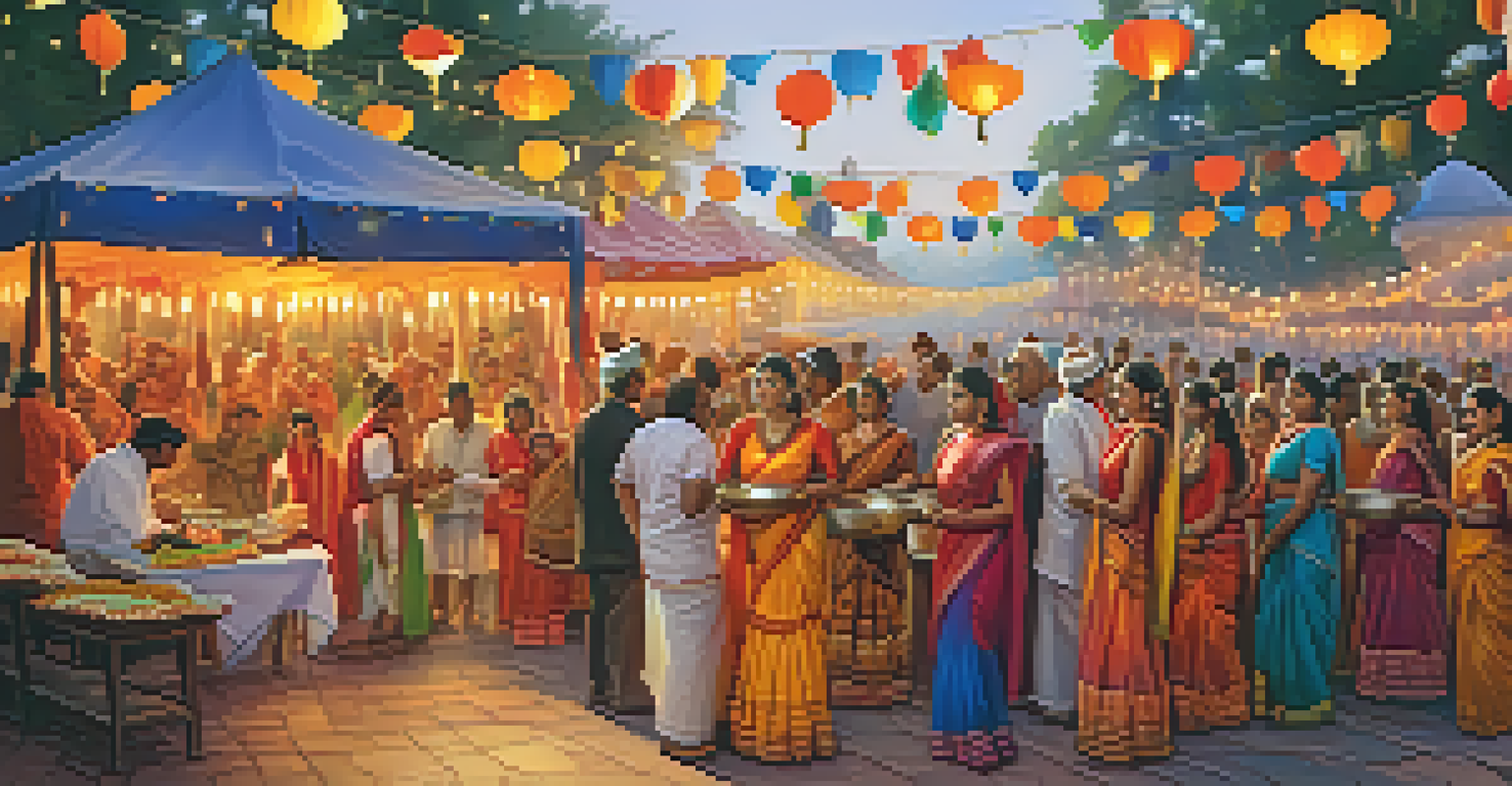Key Historical Events in India Reenacted for All to Enjoy

The Epic Battle of Panipat Comes to Life
The Battle of Panipat, fought in 1761, is a pivotal moment in Indian history that shaped the subcontinent's future. Reenactments of this grand battle transport audiences back in time, showcasing the valor and strategy of the Marathas and the Afghan forces. These events often feature elaborate costumes, traditional weaponry, and even live demonstrations of battle tactics.
History is not a burden on the memory but an illumination of the soul.
Attending a reenactment allows spectators to witness not just the clash of swords but also the emotional intensity that soldiers experienced. With actors portraying historical figures, audiences can connect with the bravery and sacrifice that defined this monumental conflict. It's a powerful way to learn history that goes beyond textbooks.
Such events also spark discussions about the cultural implications of the battle and its lasting effects on India's socio-political landscape. By engaging with history through performance, people of all ages can appreciate the complexities of the past while enjoying a thrilling spectacle.
Mahatma Gandhi's Salt March: A Symbol of Resistance
One of the most iconic events in India's struggle for independence is Mahatma Gandhi's Salt March in 1930. Reenactments of this peaceful protest highlight Gandhi's role in challenging British colonial rule, showcasing his philosophy of non-violence. Participants often walk similar routes, clad in simple white clothing, embodying the spirit of the movement.

These reenactments not only educate the public about the significance of the Salt March but also inspire a new generation to engage in peaceful activism. They serve as a reminder that change can be achieved through non-violent means, making Gandhi's message more relevant today than ever. Storytelling through reenactment adds a personal touch, allowing audiences to feel the weight of history.
Reenactments Bring History Alive
Engaging reenactments of significant historical events allow audiences to connect emotionally with the past and appreciate its complexities.
Moreover, the events often include discussions and workshops that delve deeper into the implications of the Salt March. This interactive approach fosters a sense of community and encourages attendees to reflect on their own roles in promoting justice and equality.
The Great Revolt of 1857: A Fight for Freedom
The Great Revolt of 1857, also known as the First War of Independence, marked a significant turning point in India's colonial history. Reenactments bring this tumultuous period to life, highlighting the bravery of sepoys and civilians who rose against British rule. These performances often include dramatic representations of key events, stirring emotions among viewers.
To be a part of history is to understand the struggles and triumphs of those who came before us.
By witnessing these reenactments, attendees gain insight into the causes and consequences of the revolt. The stories of heroes like Rani Lakshmibai and Mangal Pandey become more tangible, allowing for a deeper appreciation of their sacrifices. This immersive experience fosters a stronger connection to India's rich history.
Additionally, these events often serve as a platform for discussing the ongoing struggles for freedom and equality in today's world. Connecting past and present encourages participants to reflect on their own roles in shaping a just society.
The Cultural Renaissance: The Bengal School of Art
The Bengal School of Art emerged in the early 20th century as a response to British artistic influences, celebrating Indian culture and heritage. Reenactments of this cultural renaissance often include exhibitions, performances, and workshops that showcase traditional techniques and philosophies. Artists and performers collaborate to bring the essence of this movement to life.
By attending these events, people can witness firsthand the beauty of Indian art forms such as painting, dance, and music. The reenactments highlight the contributions of influential figures like Abanindranath Tagore, who played a vital role in shaping modern Indian art. It's a vibrant celebration of creativity that resonates with audiences of all backgrounds.
Cultural Heritage Through Festivals
Vibrant reenactments of Indian festivals foster community and deepen appreciation for cultural traditions and their historical roots.
Moreover, these events facilitate discussions about the importance of cultural identity and heritage in today's globalized world. By connecting with the past, participants are encouraged to explore their own artistic expressions and appreciate the richness of India's diverse culture.
The Partition of India: A Narrative of Loss and Hope
The Partition of India in 1947 was a tragic event that led to immense suffering and displacement. Reenactments focused on this period often incorporate storytelling, music, and visual arts to convey the emotional weight of the events. Participants share personal narratives that highlight the human impact of political decisions, fostering empathy and understanding.
These powerful performances allow audiences to reflect on the complexities of communal relationships and the importance of coexistence. By acknowledging the pain of the past, these reenactments promote healing and reconciliation. They serve as a reminder that while history can be painful, it also holds lessons of resilience and hope.
Additionally, discussions held during these events often encourage dialogue about current social issues, emphasizing the need for unity in diversity. By connecting past traumas with contemporary challenges, attendees can find common ground and work towards a more inclusive future.
Celebrating the Rich Heritage of Indian Festivals
India is known for its vibrant festivals, each with its own unique historical and cultural significance. Reenactments of festivals like Diwali, Holi, and Eid allow participants to experience the joy and traditions associated with these celebrations. Through music, dance, and storytelling, audiences can immerse themselves in the rich tapestry of Indian culture.
These events foster a sense of community and belonging, as families and friends come together to celebrate shared heritage. By participating in reenactments, attendees learn about the historical roots of these festivals, deepening their appreciation for the customs and rituals that have been passed down through generations. It's a delightful way to engage with culture.
Empowering Women's Historical Roles
Highlighting the contributions of women in India's freedom movement encourages discussions about gender equality and empowerment today.
Moreover, these celebrations often include interactive elements, such as workshops and food stalls, that encourage participation and connection. Attendees leave with not only memories of the festivities but also a greater understanding of the cultural significance behind them.
The Role of Women in India's Freedom Movement
Women played a crucial role in India's struggle for independence, often overlooked in mainstream narratives. Reenactments that focus on figures like Sarojini Naidu and Rani Lakshmibai bring their stories to the forefront, showcasing their courage and leadership. These performances inspire audiences to recognize the contributions of women in shaping history.
By highlighting these stories, reenactments encourage discussions about gender equality and empowerment in contemporary society. Participants can reflect on the progress made and the work that still lies ahead. This focus on women's voices adds depth to the understanding of India's freedom movement.

Additionally, these events often serve as platforms for promoting women's rights and celebrating achievements in various fields. By connecting the past with the present, attendees are inspired to support and uplift women in their communities.
The Legacy of India's Rich Architectural Heritage
India boasts a wealth of architectural marvels that reflect its diverse history and culture. Reenactments held at historical sites like the Taj Mahal or Hampi allow visitors to experience the grandeur of these structures while learning about their significance. These events often include guided tours, storytelling, and performances that bring the history of these sites to life.
By immersing themselves in the stories behind the architecture, attendees can appreciate the skill and artistry of the craftsmen who built them. Reenactments highlight the cultural exchange that occurred over centuries, showcasing how architecture evolved in response to various influences. It's a fascinating way to explore India's heritage.
Moreover, these events often promote discussions about preservation and conservation efforts. Attendees are encouraged to reflect on their role in safeguarding these treasures for future generations, fostering a sense of responsibility and pride in India's rich architectural legacy.